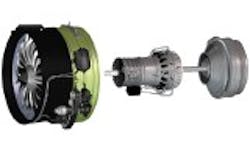CFM, GE making jet-engine parts using additive manufacturing
CFM International, a 50/50 joint venture between GE and France's Snecma, and GE's Global Research Center in Niskayuna, NY, say they are working on a laser additive manufacturing process to produce parts for CFM's Leap family of turbofan engines, which significantly reduce the weight and amount of material used, translating directly into cost savings.
The Leap engine is CFM's next-generation jet engine, a high-bypass turbofan engine weighing "several hundred pounds" less than conventional engines. Leap engines are expected to reduce fuel consumption by 15% -- saving $12 million annually in fuel costs per aircraft (assuming $2.50/gal of jet fuel and a 15-year ownership horizon), and eliminating roughly 46,300 metric tons of CO2 emissions. Full Leap engine tests are slated to begin in mid-2013 with deliveries beginning in 2016; orders and commitments totaled $47.5 billion in 2011, and it's received "billions more this year."
The Leap engine is getting a lot of attention at this week's Farnborough International Air Show in the UK. Boeing, for example, has secured hundreds of new orders for the 737 MAX line of aircraft which uses a Leap-1B engine.
Among the Leap engine's new features is its incorporation of additive manufacturing processes to "print" engine components layer-by-layer, enabling creation of parts with more complicated geometries and structures that are more efficient and lighter-weight. GE isn't specifying which Leap parts are being made with additive manufacturing -- it makes the engine's "hot" core section of the engine including compressor, combustor, and high-pressure turbine, while Snecma makes the front fan and low-pressure turbine. But a GE rep did tell ILS that, thanks to the one-piece manufacturing method, "we can avoid having to braze 15-20 piece parts together to form one component," and it enables more design freedom to create unique, otherwise "unmanufacturable" components.
The end result is a 30%-40% reduction of weight and amount of material -- a critical cost factor for an industry that is increasingly relying on expensive metals to reduce weight, and is ruled by a "buy-to-fly" ratio comparing how much starting material is required vs. what's eventually used in a part.

